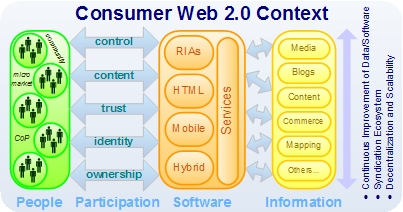Exploiting the power of enterprise wikis

As part of my recent exploration of developing strategies for using Web 2.0 in the enterprise, I find that time and again the lowly wiki presents itself as the most likely target for the initial adoption in the enterprise. For one thing, almost everyone has heard of a wiki, that Web page that anyone authorized to can edit at the push of a button, all without knowing even a smidgen of HTML.
Famous exemplars help too, and Wikipedia is of course the most well-known example of a wiki. But it's good wiki products for the enterprise that make it all real however, and with this in mind I cited a number of enterprise-quality wiki products in my recent Enterprise Web 2.0 software list.
Many of us are familiar with the practice of quickly setting up a wiki to work on a team project and centrally collect and organize information with little actual central control and usually a minimum of setup and configuration. To take it to the next level however, a post I came across today via Marshall Kirkpatrick points to a fascinating article by Michael Hickins that hints at the deeper, underlying potential of wikis to provide potent returns for relatively minor investments.

However, before we get into details of the full potential of wikis in the enterprise, let's take a quick tour again of the context we're using for this effort. While the full vision of Web 2.0 is largely contained in this detailed diagram of Web 2.0, I've provided a simpler version above that really focuses on the key aspects that we'll primarily explore here. While it still looks a little formidable, the net result accurately depicts a view of online software that fosters decentralized communities of involved, contributing users that are in turn empowered by trust, control, and open tools.
I often talk about the trinity of Web 2.0: People, Information, and Software, in that order. But I've added a verb to the trinity in the diagram above, in order to make clear that's the people – on the Web or on the intranet – that actually provide the valuable content by virtue of their participation: attention, content, and other collaborative efforts that they bring to the table. (See Ross Mayfield's great Power Law of Participation for the full spectrum participation activities.)
The article by Hickens that I mention above makes some particularly interestings points about structure, again emphasizing what we're increasingly coming to understand as the complexity of tools inhibiting the very things that we're trying to do with them. Hickens cites the success of BizWiki by CustomerVision, both in terms of lowered barriers to capturing content as well as adoption by enterprises:
BizWiki, which is provided as an on-demand service, allows users to create and edit content without having to adhere to a rigid content management format.It also allows users to get authoritative information using an "Ask the Expert" function. Responses from designated experts can be automatically posted as a piece of content. "It helps corporations retain intellectual capital and dynamically build their content bank," said Brian Keairns, CustomerVision founder and vice president of product management.
And the business world seems to be biting. Without the benefit of a marketing push, CustomerVision has won over about 100 customers. The company also said that revenue has been growing by more than 300 percent per year. Many of its customers are Fortune 1000 companies shelling out anywhere from $100 to $5,000 per user per month, depending on the size of the implementation.
Interestingly, the article also notes that some enterprises want to be able to connect their wiki into existing workflow processes within the organization. This could be another bit of useful enterprise context that we can add to the mix. In fact, I've discussed in the past how guided interactions will be increasingly important in the enterprise as services, enterprise mashups, and BPM are woven into the fabric of complex business processes.
However, this level of integration may again impose too much structure and runs the risk of raising the barrier to participation to an undesirable level. Mark Choat, wrote about similar issues recently in his enterprise wiki article on CMSWatch and agrees, noting:
The fact that wikis are decentralized and lack sophisticated workflow systems and approval processes is considered a feature of wikis and not a fault. This is contrary to the basic philosophy of many content management systems, which emphasize control over empowerment.
Enterprise Context for Wikis
Blogs and wikis are slightly different forms of two-way content management; they diiffer significantly in who is allowed to subsequently control what is published (blogs typically only let the original publisher change content, while wikis often let anyone change anything.) Given however, their similarity in other respects, I believe the enterprise context overlaps extensively between the two. In this vein, and adding what we've already learned about the enterprise context of blogs, et's take a look at the enterprise context for wikis:
- Integrated Enterprise Security (SSO, LDAP, Identity 2.0, etc.)
- Content Auditing and Policy Support (Automated)
- Open and extensible (inbound and outbound integration points)
- Support for enteprise search
- Internal and exernal hosting options
- Integration with standard workflow products and standards (BPEL, for instance)
Up next: Blogs and wikis are self-guided content management tools. Guided content management and workflow integration might be valuable, or it might impede the emergence of tacit interactions, something that many believe are the next big frontier in worker productivity. We'll look at things like BPM 2.0 next.
What other context is missing ? And should any enterprise context for wikis be taken away?